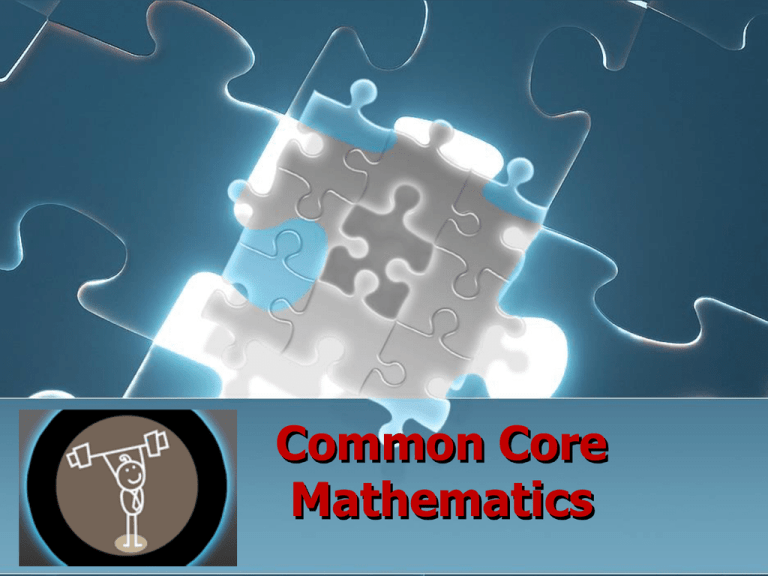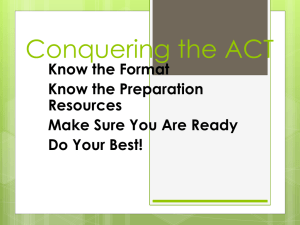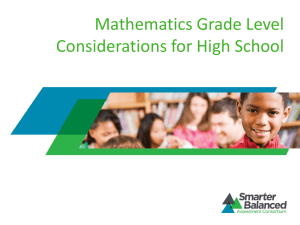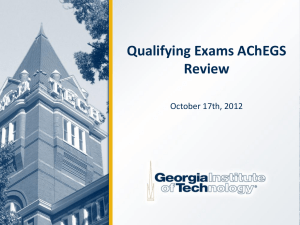OCSD July PD High
advertisement

Common Core Mathematics Learning Norms • Restrooms • Parking Lot • evaluation connections • General comments 2 Today’s Learning Goals 1. Identify and interpret the 8 Mathematical Practices of Common Core. 2. Organize and differentiate “blended” standards 3. Develop a Learning Progression Scale 4. Identify tools and resources developed to support the implementation of CCSS. 3 Success Criteria 1. Develop a learning goal using resources that support CCSS. 2. Apply the model of a Learning Progression Scale with math practices in mind. Introductions Name School Title Subjects Taught Years in Education Why is math important? Warning: Much of the action depicted and/or described on this site is potentially dangerous. Virtually all of the participates seen in the photos are experienced professionals. Do not attempt to duplicate. 8 Standards for Mathematical Practice Make sense of problems and persevere in solving them Use appropriate tools strategically Reason abstractly and quantitatively Attend to precision Construct viable arguments and critique the reasoning of others Look for and make sense of structure Model with mathematics Look for and express regularity in repeated reasoning 3b, 3c 7 Let’s Practice 8 Review – Relate - Reflect Review the 8 Mathematical Practices Relate how to use a MP in your classroom Reflect one new idea 9 Course Descriptions 10 Common Core Format High School Conceptual Category Domain Cluster Standards Florida’s Numbering of the Common Core State Standards MACC.912.A.CED.1.4 Math Common Core Grade Conceptual Category Domain Cluster Standard Grade 9-12 Conceptual Algebra Category Domain Creating Equations Cluster Create equations that describe numbers or relationships Standard Rearrange formulas to highlight a quantity of interest, using the same reasoning as in solving equations. Compare National to State Notation National: CCSS.Math.Content.HSA-SSE.B.3 Florida: MACC.912.A-SSE.2.3 Using the Course Description…. Questions to Ponder How do you know when a student can use, explain and apply a standard? What are different stages of mastering a standard? 15 Model for Instructional Planning Learning Goals • Create the learning goals/targets based upon the critical areas of focus or big ideas along with the integrated standards from the course description. Chunking • Identify the standards of focus from course description to support learning goal and differentiate levels of understanding. • Develop scales or rubrics to describe the steps students will take to attain each learning goal as Learning well as what success looks like at each step. Progression 16 Model from Algebra 1 • Review and Analyze Unit • Write Learning Goal • Identify standards to support Learning Goal 1c, 1e 17 Review and Analyze Unit Unit 1- Relationships Between Quantities and Reasoning with Equations: By the end of eighth grade students have learned to solve linear equations in one variable and have applied graphical and algebraic methods to analyze and solve systems of linear equations in two variables. This unit builds on these earlier experiences by asking students to analyze and explain the process of solving an equation. Students develop fluency writing, interpreting, and translating between various forms of linear equations and inequalities, and using them to solve problems. They master the solution of linear equations and apply related solution techniques and the laws of exponents to the creation and solution of simple exponential equations. All of this work is grounded on understanding quantities and on relationships between them. 18 Write Learning Goal Learning Goal: Students analyze and explain the process of solving an equation. They master the solution of linear equations and apply related solution techniques. Essential Question ideas: • In what ways can the problem be solved, and why should one method be chosen over another? • How can algebra describe the relationship between sets of numbers? 19 Standards for Learning Goal MACC.912.A.REI.1.1 MACC.912.A.REI.2.3 MACC.912.A.CED.1.4 MP #1 #3 20 Let’s Practice 21 Review – Relate - Reflect Review Learning Goal Development Relate how to use Learning Goals in your classroom Reflect on a new idea 22 LEARNING PROGRESSION 1. Identify mastery 2. Differentiate levels of understanding 3. Create example problems 1a, 1b, 1c, 1e, 3d 23 Sample Step 3 (Target) Sample Step 0 Sample Step 1 Sample Step 2 Sample Step 4 Let’s Practice 29 John Hattie’s High Yield Strategies Formative Assessments =0.90 Self Assessments d = 0.64 3d Review – Relate - Reflect Review Learning Progression Development Relate how to use Learning Progressions in your classroom Reflect on a new idea 31 Piecing it ALL Together Common Core Mathematics











